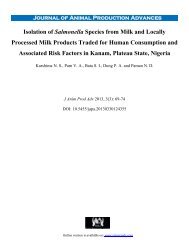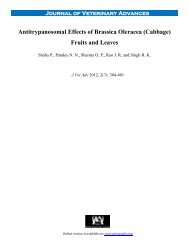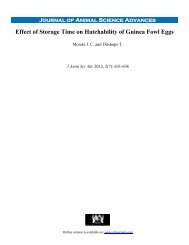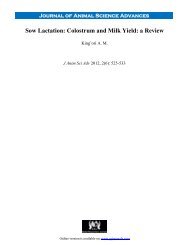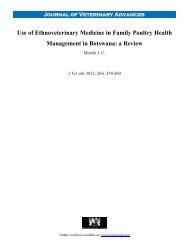PDF Download
PDF Download
PDF Download
Create successful ePaper yourself
Turn your PDF publications into a flip-book with our unique Google optimized e-Paper software.
EKEOCHA<br />
Table 5: Feed intake of ewe during lactation (g/day)<br />
Treatment A(0%MSLM) B(15%MSLM) C(30%MSLM) D(45%MSLM) SEM<br />
Early Lactation<br />
Concentrate 356.14 ab 604.57 a 319.17 ab 204.74 b 213.81<br />
Grass 147.15 b 178.25 b 243.23 a 237.08 a 35.76<br />
Total DMI 503.29 782.81 562.39 441.82 226.17<br />
DMI g/dWkg 0.75 106.26 147.99 115.49 96.37 69.36<br />
DM ÷ LW% 2.55 3.86 2.70 2.27 1.12<br />
Mid Lactation<br />
Concentrate 362.80 ab 615.87 a 325.13 ab 208.57 b 219.81<br />
Grass 149.90 b 181.58 b 247.77 a 241.51 a 43.61<br />
Total DMI 512.69 797.44 572.91 450.06 240.00<br />
DMI g/dWkg 0.75 107.74 150.06 117.10 97.71 70.32<br />
DM ÷ LW% 2.73 3.96 2.94 2.44 1.20<br />
Late Lactation<br />
Concentrate 349.50 ab 593.30 a 313.20 ab 200.92 b 209.82<br />
Grass 144.39 b 174.92 b 238.68 a 232.64 a 35.09<br />
Total DMI 493.90 768.20 551.90 433.56 221.94<br />
DMI g/dWkg 0.75 104.77 145.92 113.87 95.01 68.28<br />
DM ÷ LW% 2.77 3.83 2.90 2.46 1.18<br />
ab means on the same row with different superscripts differ significantly (P0.05) with increasing inclusion of<br />
MSLM. Kruip-Tam et al (1996) earlier enunciated<br />
the occurrence of an apparently unavoidable post<br />
partum negative nutrient balance in animals selected<br />
for milk yield. The combination of increasing<br />
demand for milk yields and insufficiently increased<br />
feed intake capacity led to a gap between energy<br />
input and energy output at the onset of lactation<br />
which could only be compensated for by lipolysis<br />
and protein mobilization from body tissues resulting<br />
in net loss in weight. Owens (1981) further<br />
highlighted that the requirements of a ewe in peak<br />
lactation are approximately three times those of a<br />
dry ewe. However, it is normally impracticable to<br />
increase the energy concentration of the diet<br />
sufficiently to match this increased demand<br />
particularly since ewe in the first 3-4 weeks of<br />
lactation have not reached maximum voluntary feed<br />
intake. Observed variations were not significant<br />
(P>0.05) on reproductive performance although<br />
animals on treatment B was superior to others in<br />
weight at parturition, lamb birth weight, shorter<br />
gestation length and weight gain during pregnancy.<br />
Conclusions<br />
Mexican sunflower leaves provides an<br />
opportunity to enhance utilization of the fibrous<br />
fraction, and to raise the overall protein and energy<br />
density of ruminant diets thus sparing wheat bran<br />
which is unsustainable all year round due to<br />
seasonal effect. There will also be potential for<br />
indirect environmental benefits from making greater<br />
use of MSL in ruminant diets, because of the<br />
environmental pollution associated with burning of<br />
MSL. However, this potential will only be realized<br />
in practice when the improved supply of digestible<br />
energy at the level of the rumen is reflected in<br />
improved animal performance, which requires a<br />
concomitant improvement in the balance of<br />
essential nutrients available for metabolism by the<br />
animal and possibly production of meat. Based on<br />
the overall performance, inclusion of 15% Mexican<br />
sunflower leaf meal in the diets of lactating ewes<br />
appeared most beneficial to sheep as it improved<br />
dry matter intake and reproductive performance but<br />
731 J. Anim. Sci. Adv., 2012, 2(9):727-733





